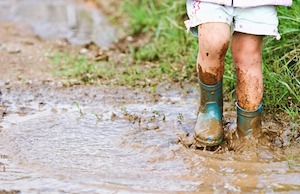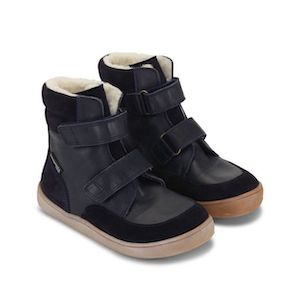
We now have a wonderful range of minimal waterproof and water-resistant kids boots for walking, hiking, outdoor play and everyday use. It used to be a real challenge to source non rubber barefoot waterproof boots. However, these days we have a lot more options available to choose from and we are delighted to be able to offer a good range to meet all requirements. So many so that we now have a dedicated section on our website where we have curated a range of all of our recommendations HERE.
Waterproof Boot Options
Wellingtons
Wellington boots are the usual go-to choice when a waterproof boot is required. They have the advantage of being waterproof up to the height of the boot and are easy to put on and off. They are hugely popular and we now have a fantastic selection of barefoot friendly Wellies from Aigle, Bundgaard, Mikk-Line, Spotty Otter, Igor. However, desite being the go to waterproof boot for many, they are not that easy to keep secure on the foot as they have no straps. This can cause issues around the gripping of toes and slippage on the heel. As a result, we only recommend wellington boots for limited wear and only when they are really needed, for example wading and puddle jumping.

Waterproof Walking boots
For more everyday use a waterproof boot can be a better option. They will usually have some means of securing the boot to the foot, through Velcro straps or laces and therefore it is much easier to get a good fit. This means they are suitable for longer periods of wear.
A waterproof boot is usually made of leather or textile with a waterproof membrane. As it usually has a tongue it is often only waterproof up to the level of the tongue. A gusseted tongue extends the height of the waterproof membrane, but it is rarely as high as the height of the boot. This means that it is easy for water to get over the top of the boot and cause wet feet.
For this reason, we don’t recommend these boots for wading or puddling jumping, even if they are designated as waterproof.
The Boots
Freet Tufee
New for 2024 the Tufee boots from Freet are our only waterproof boot specifically designed for walking and hiking and our first choice for outdoor adventures. They are on the GripPlus performance outsole which is designed for good traction off-road. It has a stack height of 8.5mm, with insole in, or 5.5mm with insole removed so you can customise the level of cushioning and get excellent ground feel.
Froddo
Froddo are our most popular option and offer a range of waterproof boots in both leather and textile with a great choice of colours and styles, all with a waterproof membrane.

Bundgaard Basil
The Bundgaard Basil is rapidly becoming our favourite waterproof boot for its lovely wide fit, ultra-barefoot sole, super soft leather upper and warm wool lining. The waterproof membrane also comes nice and high up the boot for good reliability. It is a great choice if you want the maximum level of waterproofing in a leather boot, however it doesn't have the grippiest sole so wouldn't be the first choice for off-roading on slippier surfaces.
Bobux Timber Arctic
The Bobux Timber Arctic is now one of the few waterproof options that Bobux produce. It is however one of the best waterproof options with a very reliable waterproof membrane, gusseted tongue and wool lining.
Be Lenka Winter Kids
These boots have a waterproof membrane but due to the issues of water ingress over the top of the tongue are only described as water resistant by Be Lenka. However they are such a good barefoot option and are very popular for outdoor use. We have them available in this lovely chocolate colour and an ocean blue.
Vivobarefoot Kids Ludo Hi Boots
Again, another boot only described as water resistant but with excellent properties are the Vivobarefoot Ludo Boots. A great outdoor barefoot boot that is rightly popular with our customers.

Issues to consider
Sole Stiffness
Quite often the glues used in waterproof boots increase the stiffness of sole units and impact their barefoot credentials. This isn’t true of all brands but can be an issue to watch out for. We always try and note where this is the case. Usually, the boots soften up with use but can feel a lot stiffer than non-waterproof options from the same brand on receipt. This can be a bit disconcerting, and it is important to check how your child walks in the boots to be sure this isn’t going to cause any slipping or tripping in a sensitive walker.
Waterproof Membrane
In a non-rubber boot, the waterproofing is achieved through the use of a waterproof membrane which sits between the outer and inner layers of the upper. In some boots this membrane goes all the way around the foot, including over the sole, eg in a Bogs Boot. However, in others the membrane is just in the upper part of the boot (eg Froddo) and waterproofing of the sole is achieved through use of the gluing of the sole to the upper.
We don’t recommend non rubber boots for wading or paddling as generally waterproof membranes aren’t as waterproof for such an extended period as a rubber welly.
Waterproof membranes also do need a bit of careful usage and maintenance to ensure they continue to stand up to the rigours of active usage. They will degrade over time and once punctured will leak. They benefit from the regular application of a waterproofing spray to minimise leakage. As a result of the fault rates of waterproof boots are much higher than that of non-waterproof options from the same brand.
Height of Boot
Another big issue is water ingress over the top of the boot. Whilst we don’t recommend prolonged paddling or wading in a non-rubber waterproof boot it does happen! In this case be aware of the height of the boot, particular if there are cut out sections at the back to ensure easy on and off. Also most waterproof boots are only waterproof to the height of the start of the tongue of the boot or gusset. This means that water will ingress even if the water doesn't reach the full height of the boot. Something to consider as you think about where your child will wear the boots and what they are likely to do in them!
Sweaty Feet
Something else to consider is sweaty feet! With a waterproof membrane a boot won’t be as breathable as a normal leather boot. This can lead to increased sweating resulting in wet feet when you take the boots off. It can sometimes seem as though the boot has leaked when in reality it is the breathability that is the issue. We have no solutions to offer here except to note that if your child is prone to this a waterproof membrane may not be the best option and it might be preferable to use a normal leather boot for everyday with wellies for puddle jumping.
Maintenance
For a non-rubber waterproof boot with a waterproof membrane or water resistant layer it is important to practice proper maintenance of the boots to maximise the life of the membrane.
Boots should be dried carefully after use, away from direct heat. We usually recommend stuffing with newspaper or old towels and leaving in a warm space to slowly dry. Once dry any excess mud should be brushed off.
Regular treatment with either a waxy polish for a leather boot or a waterproofing spray is also essential. We would advise treating with the spray prior to first use and after every time the boots have been wet.
Testing for waterproofing
Occasionally a waterproofing membrane will fail, either through damage or prolonged use. If you feel that the membrane has failed due to manufacturing error it is important to test this first and ensure that the cause of the wet feet is not water ingress or sweat.
To test if the membrane is working we suggest drying the boots out thoroughly as detailed above. If you then stuff the boots with dry newspaper or towels and stand them in a bowl of water that just covers the toes of the boots but ensures it is below the height of which the boot is waterproof. If you leave for 15 minutes and then remove the towels/paper. If they are wet the membrane has failed. If they are dry then it is worth looking at other causes of wet feet and reviewing the use of the boots.
 Free UK Returns
Free UK Returns








Comments